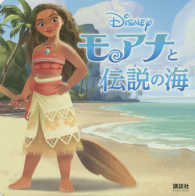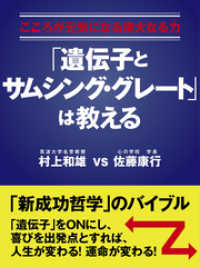- ホーム
- > 洋書
- > 英文書
- > History / World
Full Description
Discussions on consanguineous marriage within Egyptology usually focus on brother-sister marriages recorded in census returns from Roman Egypt, or royal sibling marriages amongst the ruling Ptolemies. However, no wide-ranging review exists of non-royal consanguineous marriage in ancient Egypt despite the economic and biological implications of such relationships. This is the first time that evidence for nonroyal consanguineous marriage in ancient Egypt has been collated from select sources spanning the Middle Kingdom to the Roman Period and a method created to investigate the potential economic and biological outcomes of these unions, particularly beyond the level of sibling and half-sibling unions. The working definition of consanguineous marriage used throughout this study is that used by clinical geneticists: unions contracted between cousins biologically related as second cousins or closer biological kin. This research argues that for some families, and under certain conditions, consanguineous marriage was a preferred economic strategy in terms of gifts given at marriage and in inheritance, and that families who married consanguineously may have received greater levels of intra-familial support without the expectation of reciprocity. Although there may have been adverse biological outcomes arising from congenital anomalies and genetic disorders in the offspring of consanguineous marriages, the research suggests that it is unlikely that these physical or cognitive disorders were distinguished from other medical disorders in the general health environment of ancient Egypt. The investigation focuses primarily on ancient Egyptian documentary and archaeological sources, including human remains, and is informed by research on consanguinity from a range of disciplines including anthropology, demography, economics and pathology.
Contents
Acknowledgements ;
Abbreviations ;
Glossary ;
Ancient Egyptian Chronology ;
Papyri and ostraca ;
Chapter 1: Ancient Egyptian marriage and kin terms, definitions of consanguinity and consanguineous marriage ;
Chapter 2: Consanguinity in historical context: evidence from select sources for consanguineous marriage in ancient Egypt, the Near East, Greece and Rome ;
Chapter 3: The use of inheritance and matrimonial goods as economic strategies in non-royal consanguineous families ;
Chapter 4: Consanguineous marriage in Deir el-Medina and economic impacts: family interrelationships, occupations, offspring, and expectations of altruism and reciprocity ;
Chapter 5: Biological outcomes of non-royal consanguineous marriage: prevalence, impact and perceptions of abnormality in ancient Egypt ;
Chapter 6: Conclusion ;
Appendix 1: Table of probable or possible non-royal consanguineous marriages from select sources ;
Appendix 2: Details of consanguineous and affinal links between consanguineously married couples in Deir el-Medina ;
Appendix 3: Number of known children in the eight family trees in which there are consanguineous marriages ;
Bibliography








